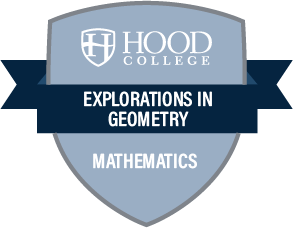Badge Overview
 Explorations in Geometry
Explorations in Geometry
Published Public {} Badge Class Data
Explorations in Geometry

Issued by Hood College
Badge Description
The Exploration in Geometry badge offers a look at basic geometry from a more sophisticated point of view, including more advanced Euclidean and non-Euclidean geometries. Topics covered may include analytic geometry, spherical geometry, hyperbolic geometry, fractal geometry and transformational geometry. Dynamic geometry software will be an integral part of the course.
Problem Solving
Perseverance
Reasoning
Communication
Mathematical Arguments
Badge Criteria
This FOUNDATIONAL level badge is equivalent to a 3-credit, master's-level course. A final grade of B or better is required to earn this badge.
Aligned Outcomes
-
Internal
Core Competencies
https://www.hood.edu/offices-services/institutional-assessment/institutional-learning-outcomesGSO_CommCommunication
The badge earner will communicate clearly and effectively in oral, written and/or visual formats, consistent with the standards of their discipline.
-
Internal
Core Competencies
https://www.hood.edu/offices-services/institutional-assessment/institutional-learning-outcomesGSO_CriReasCritical Reasoning
The badge earner will approach content and tasks with a critical awareness, framed by knowledge and skills appropriate to their discipline.
-
Internal
Core Competencies
https://www.hood.edu/offices-services/institutional-assessment/institutional-learning-outcomesGSO_ProbSolvProblem Solving
The badge earner will apply advanced disciplinary content knowledge and strategies to understand and address problems and questions relevant to their discipline and to which they have not previously been introduced.
